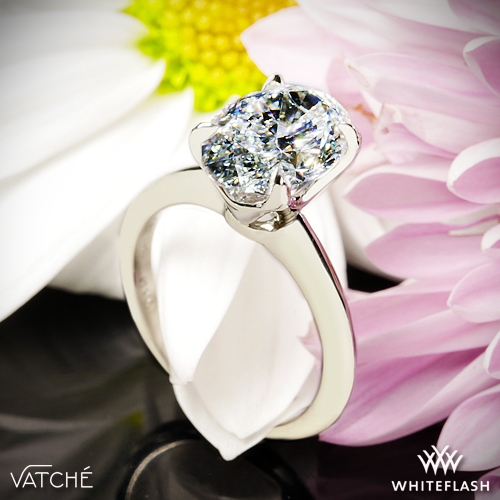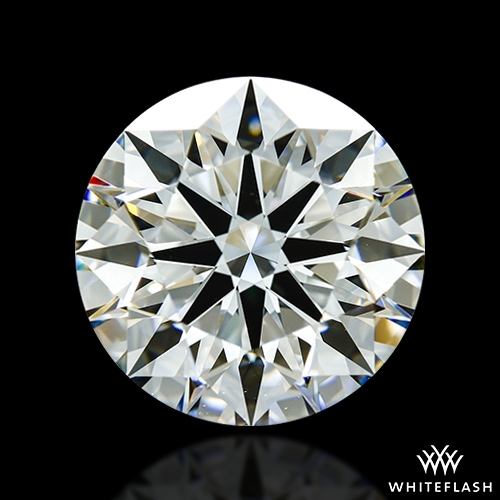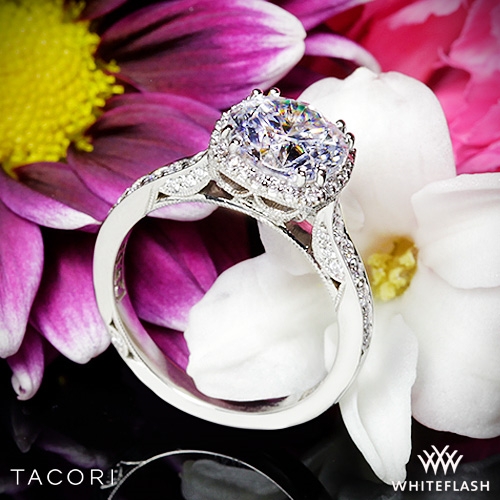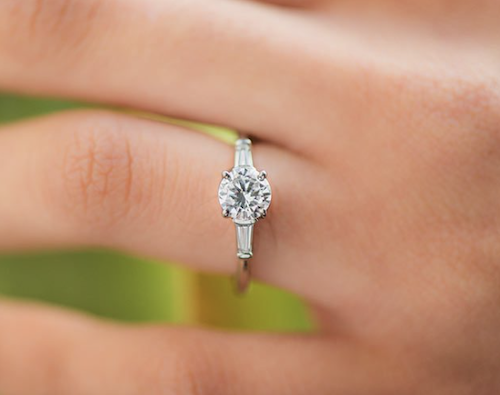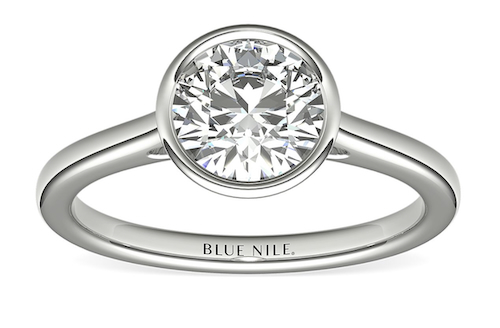Diamond Education
3 Carat Diamond Guide
Among the spectrum of diamonds, a 3-carat stone holds a unique allure. It's a size that is not just impressive, but that also embodies an exquisite blend of rarity and sophistication.
In this comprehensive guide, we'll explore the captivating world of 3-carat diamonds. These are not your average gems. Their size, while certainly significant, is just the tip of the proverbial iceberg when it comes to their appeal. We'll delve into the various factors that influence a 3-carat diamond's size and appearance, its cost, and the differences between natural and lab-grown varieties.
From the possible settings that can further enhance its beauty, to tips on selecting the perfect 3-carat diamond, and finally, where to find these magnificent stones, we'll cover everything you need to know. Whether you're considering a purchase for a special occasion or simply wish to enrich your knowledge about these dazzling gems, this guide on 3-carat diamonds is designed to cater to your curiosity and provide you with valuable insights. Let's embark on this sparkling journey together.
Summary
- How Big is a 3 Carat Diamond?
- How much does a 3 Carat Diamond Cost?
- Natural 3 Carat Diamonds
- Lab-Grown 3 Carat Diamonds
- 3 Carat Diamond Settings
- Where to Buy 3 Carat Diamonds
How Big is a 3 Carat Diamond?
When it comes to understanding the size of a 3 carat diamond, we need to look beyond carat weight. While 'carat' indicates the diamond's weight, not its dimensions, it does give a rough idea about the size. Diamonds are measured in millimeters, and the millimeter size can vary depending on the diamond's cut and shape.
Here's a quick breakdown:
Carat vs. Size: One carat equals 200 milligrams or 0.2 grams in weight. However, when it comes to size, carat weight is not a direct measure as the dimensions depend on the diamond's shape and cut. This is why two diamonds of the same carat weight might appear to be different sizes.
Size of a 3 Carat Round Diamond: A well-cut round diamond with a 3 carat weight will typically measure about 9.3 millimeters in diameter. Round cut is the most popular diamond cut and is valued for its ability to maximize light return and sparkle.
Size of a 3 Carat Diamond of Other Shapes: The millimeter measurements for other diamond shapes (also known as 'fancy shapes') can vary. For instance, a 3 carat oval diamond will typically measure around 10.9 x 7.4mm, while a 3 carat emerald cut diamond might measure about 9.5 x 7.3mm.
To provide a more comprehensive overview, let's look at a table that indicates the typical millimeter dimensions for different shapes of a 3 carat diamond.
Diamond Shape Typical Measurements (L x W in mm)
| Diamond Shape | Typical Measurements (L x W in mm) |
|---|---|
| Round | 9.3 x 9.3 |
| Oval | 10.9 x 7.4 |
| Princess | 7.5 x 7.5 |
| Emerald | 9.5 x 7.3 |
| Asscher | 7.8 x 7.8 |
| Cushion | 8.2 x 8.2 |
| Marquise | 15.5 x 7.5 |
| Radiant | 8.7 x 6.9 |
| Pear | 11.5 x 7.5 |
| Heart | 8.7 x 8.7 |
Please note that the measurements given are approximations. The actual size of a diamond can vary based on its cut quality, depth, and table size. These are important factors to consider along with carat weight when you're choosing a diamond. In the following sections, we'll delve deeper into these aspects to help you make an informed choice.
How Much Does a 3 Carat Diamond Cost?
The price of a 3 carat diamond is influenced by a multitude of factors. You may be familiar with the 'Four Cs' of diamond quality: Carat, Cut, Color, and Clarity, all of which play a significant role in determining a diamond's cost. Furthermore, the diamond's origin, whether natural or lab-grown, certification, and light performance also influence its price tag.
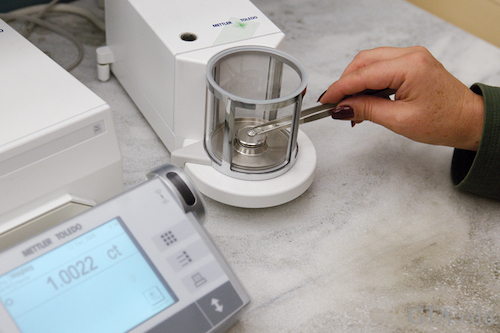
Natural 3 Carat Diamond Pricing
Natural diamonds, formed over billions of years deep within the earth, tend to command higher prices due to their rarity and unique characteristics. A 3 carat natural diamond can cost anywhere from approximately $24,500 to a staggering $125,000. This wide price range accounts for variations in the diamond's cut, color, and clarity grades. For instance, a 3 carat diamond with a high color and clarity grade and an excellent cut can be at the upper end of this price range.
Lab-Grown 3 Carat Pricing
On the other hand, lab-grown diamonds offer a more affordable alternative. These diamonds are physically, chemically, and optically identical to natural diamonds, but they are grown in a laboratory over weeks or months using high-pressure, high-temperature (HPHT) or chemical vapor deposition (CVD) methods. The cost savings come primarily from the more abundant supply and less intensive extraction process. A 3 carat lab-grown diamond's cost typically ranges from around $2,200 to $3,700.
The Impact of the Four Cs
The 'Four Cs' of diamond grading are a globally recognized standard for assessing diamond quality.
- Carat: As the carat size increases, so does the diamond's price. This is not just due to the larger size, but also because larger diamonds are rarer.
- Cut: The cut of a diamond doesn't just refer to its shape, but also how well it has been cut from the rough stone. Cut affects a diamond's brilliance and sparkle. A well-cut diamond will cost more than a poorly cut one.
- Color: This refers to the presence of any color in a diamond. The Gemological Institute of America (GIA) grades diamond color on a scale of D (colorless) to Z (light yellow or brown). Colorless diamonds are the most expensive.
- Clarity: This measures the presence of internal or external flaws, known as inclusions and blemishes. A diamond with fewer flaws will have a higher clarity grade and will be more expensive.
Certification and Light Performance Impact on Price
Certification from a trusted gemological lab ensures that you know exactly what you're buying. Diamonds certified by established organizations like the GIA are often priced higher because they are internationally recognized and trusted - many other labs have been accused of inaccuracies and overgrading.
Light performance refers to how well a diamond interacts with light, affecting its brilliance, fire (the rainbow-colored flashes), and scintillation (the pattern of light and dark areas and the flashes of light or sparkle when a diamond is moved). Superior light performance can enhance a diamond's appeal and value.
In conclusion, while a 3 carat diamond may seem like a significant investment, understanding these factors will ensure that you choose a diamond that's perfect for you and worth every penny.
Natural 3 Carat Diamonds
Natural diamonds are treasures from deep within the earth, formed under intense heat and pressure over billions of years. Each of these diamonds tells a unique story of its journey from a rough stone to a beautifully polished gem. When it comes to 3 carat natural diamonds, they are quite rare and possess a unique allure that makes them stand out in the world of gemstones.

3 Carat Diamond from James Allen
The Rarity of Natural 3 Carat Diamonds
It's important to understand the rarity of natural 3 carat diamonds. For every million carats of rough diamonds mined, only a small percentage will be of high enough quality to become gem-grade diamonds. An even smaller fraction of these will weigh 3 carats or more after they are cut and polished. Thus, owning a 3 carat natural diamond means you possess a gemstone that is quite literally one in a million.
Quality Considerations
While size is significant, the quality of a 3 carat diamond is equally, if not more, important. A diamond's quality is evaluated based on the Four Cs - Cut, Color, Clarity, and Carat weight.
- Cut: Cut is one of the most crucial aspects when choosing a natural 3 carat diamond. The precision of the cut determines the diamond's sparkle and brilliance. A diamond of this size with an excellent cut grade can truly maximize its light performance, bringing out its innate beauty.
- Color: While color preference can be subjective, generally, a color grade of H or higher is recommended for a diamond of this size to ensure any color is not readily visible to the naked eye.
- Clarity: Given their size, 3 carat diamonds are more likely to show inclusions or blemishes. It's often recommended to opt for a clarity grade of VS2 or higher for these diamonds.
- Carat: Although all the diamonds we're discussing here are 3 carats, the exact weight can vary slightly, which can also affect the price.
Certification
A certificate from a trusted gemological lab, such as the Gemological Institute of America (GIA) is particularly important when buying natural diamonds. It ensures that you're getting a diamond of the quality you're paying for, and it provides an unbiased assessment of the Four Cs.
Sustainability and Ethical Considerations
In recent years, there has been an increasing focus on the ethical sourcing of diamonds. Reputable jewelers adhere to the Kimberley Process, which is an international certification scheme that prevents conflict diamonds from entering the mainstream market. Choosing a jeweler who follows these guidelines ensures that your natural 3 carat diamond is conflict-free.
In conclusion, a natural 3 carat diamond is more than just a beautiful gem—it's a remarkable piece of the earth's history. Its rarity and inherent beauty, combined with the skill and artistry required to cut and polish it, make it a truly exceptional choice for those seeking something extraordinary.
Lab-Grown 3 Carat Diamonds
In the shimmering world of diamonds, lab-grown diamonds have emerged as a modern marvel. These stones are not mere imitations; they share the same physical, chemical, and optical properties as their natural counterparts. When it comes to 3 carat lab-grown diamonds, they offer an appealing combination of beauty, affordability, and ethical sourcing that appeals to a growing number of consumers.
The Creation Process
Lab-grown diamonds, also known as synthetic or created diamonds, are produced in a controlled laboratory environment using one of two methods: High Pressure High Temperature (HPHT) or Chemical Vapor Deposition (CVD). These processes replicate the natural conditions under which diamonds form, but they do so over weeks or months rather than billions of years.
Quality and Appearance
Like natural diamonds, lab-grown diamonds are evaluated based on the Four Cs—Cut, Color, Clarity, and Carat.
- Cut: The cut of a lab-grown diamond is as important as that of a natural diamond. A well-cut 3 carat lab-grown diamond will showcase similar brilliance and fire.
- Color: Lab-grown diamonds can be produced in a range of colors, with D (colorless) to F grades being the most desirable.
- Clarity: Lab-grown diamonds typically have fewer inclusions than natural diamonds, owing to the controlled conditions in which they are created.
- Carat: As with natural diamonds, a 3 carat lab-grown diamond is considered large, making it a luxurious and impressive choice.
Affordability
One of the key advantages of lab-grown diamonds is their affordability. A 3 carat lab-grown diamond can cost significantly less than a natural diamond of the same carat weight, often making it possible for consumers to opt for larger stones or higher quality grades within their budget.
Sustainability and Ethical Concerns
Lab-grown diamonds have a smaller environmental impact compared to mined diamonds, as they require less land and water and produce fewer greenhouse gases. They also eliminate the risk of conflict and human rights issues associated with some diamond mining operations. For many consumers, these ethical and environmental benefits add significant value to lab-grown diamonds.
Certification
Although they're created in a lab, it's just as essential for these diamonds to come with a certificate from a trusted gemological lab such as the GIA or IGI. The certificate will provide an objective evaluation of the diamond's quality based on the Four Cs. The IGI has become the most reliable and popular grader of lab diamonds since its inception.
3 Carat Diamond Settings
Choosing the right setting for your 3 carat diamond is an important decision. The setting not only affects the overall look of the diamond ring but also its functionality and security. Here, we'll delve into some popular settings for 3 carat diamonds and discuss the key considerations including the number of prongs.
Solitaire Setting
A solitaire setting features a single diamond and is known for its classic elegance. It allows the 3 carat diamond to be the center of attention and is suitable for all diamond shapes.
Halo Setting
A halo setting surrounds the main diamond with a circle of smaller diamonds. This enhances the size and appearance of the central diamond and increases the ring's overall sparkle. It can be a great choice if you want to maximize the visual impact of your 3 carat diamond.
Three-Stone Setting
In a three-stone setting, the central diamond is flanked by two smaller diamonds or gemstones. This setting not only adds additional sparkle but also carries a symbolic meaning, representing a couple's past, present, and future.
Pavé Setting
A pavé setting features small diamonds set closely together along the band, creating the illusion of a continuous sparkle. This setting can add more brilliance to your ring and enhance the beauty of your 3 carat diamond.
Bezel Setting
A bezel setting encircles the diamond with a thin metal rim, providing excellent security. This modern and sleek setting can be a perfect choice if you lead an active lifestyle.
Prong Considerations
Prongs are the small metal claws that hold a diamond securely in place. The number of prongs can affect both the security of the diamond and how much of it is visible.
Four-Prong Setting: A four-prong setting allows more of the diamond to be seen and can make it appear larger. It's suitable for most diamond shapes and offers a balanced look. However, compared to a six-prong setting, it offers slightly less security.
Six-Prong Setting: A six-prong setting is considered one of the most secure options, making it a great choice for holding a precious 3 carat diamond. The additional prongs create a symmetrical shape that can enhance the diamond's brilliance.
Regardless of the setting and number of prongs you choose, it's essential to check them regularly for wear or damage to ensure the diamond remains secure.
In conclusion, the right setting can perfectly accentuate your 3 carat diamond, enhancing its beauty and ensuring it's secure. From the classic elegance of the solitaire to the added brilliance of the halo or pavé setting, the choice depends on your style and lifestyle.
Where to Buy 3 Carat Diamonds
Choosing where to buy a 3 carat diamond is as crucial as choosing the diamond itself. There are several reputable online retailers known for their quality, customer service, and selection of diamonds and settings. Here, we’ll delve into three such top-tier options: Whiteflash, James Allen, and Blue Nile.
1. Whiteflash
Whiteflash is renowned for their exceptional quality and top-notch customer service. They offer an extensive selection of diamonds and designer settings, making them a premier choice for buying a 3 carat diamond.
Notably, they house the "A CUT ABOVE®" diamond brand. These natural diamonds are a carefully curated selection, cut with precision to deliver unmatched brilliance. Each "A CUT ABOVE®" diamond has been certified at the highest levels for cut quality and light performance by the GIA Laboratories with an AGS addendum report; a testament to their superb quality.
For those interested in lab-grown diamonds, Whiteflash offers Precision Cut Lab Diamonds. These diamonds are grown and cut with precision to ensure they match the light performance and beauty of the finest natural diamonds. Choosing from this brand allows you to enjoy the beauty of a 3 carat diamond at a more affordable price point, without compromising on quality.
2. James Allen
James Allen is another reputable online diamond retailer known for its vast selection and high-quality imaging technology. They offer a large array of diamonds in various shapes and colors, making them a go-to choice for those looking for fancy-shaped or colored diamonds.
Their intuitive online platform allows you to view each diamond from every angle with 360° HD videos, to help you find the perfect 3 carat diamond at James Allen.
3. Blue Nile
Blue Nile is well-known in the diamond industry for its wide selection of diamonds and convenient payment options. They offer a range of affordable diamond options.
Their easy-to-navigate platform simplifies the process of selecting a diamond according to your preferred specifications. They also provide various payment options, including credit card, bank transfer, and even financing plans, offering flexibility for different budget needs.
In conclusion, whether you prefer the exceptional quality and customer service of Whiteflash, the vast selection of James Allen, or the convenient payment options of Blue Nile, you're sure to find the perfect 3 carat diamond that suits your preferences and budget. Always remember to consider the diamond's certification, and ensure the vendor offers a good return policy for your peace of mind.

